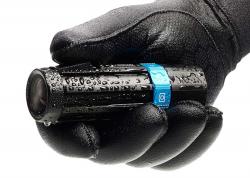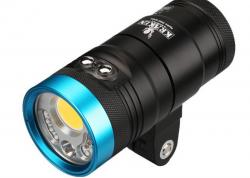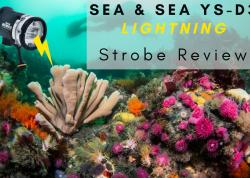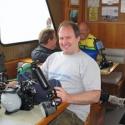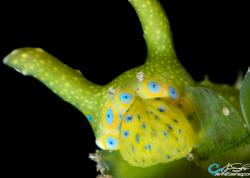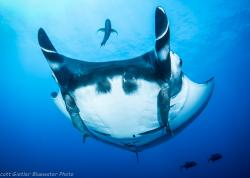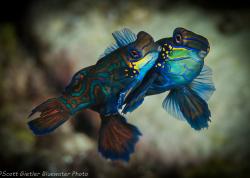Panasonic 8mm Fisheye Lens Review
The Panasonic 8mm micro-four thirds fisheye lens is a small, sharp, stunning lens that really needs to get used more often in the underwater world. It mounts on cameras such as the Olympus E-PL2 & E-PL3, and the Panasonic GF2 & GH2. You can read our guide to mirrorless cameras to get the low-down on these types of hybrid cameras, or our intro to fisheye lenses.
About the Panasonic F3.5 8mm fisheye lens
The lens has 10 elements in 9 groups. It features a silent built-in auto focus motor that makes it great for use in videos with sound. It is the world's smallest and lightest fisheye lens of its type.
Olympus E-PL2 and Panasonic 8mm fisheye lens in hand.
Topside photo with the 8mm fisheye. F8, 1/640th, ISO 200

Close-up of kelp underwater. F22, 1/180th
Underwater Testing
We took the lens down on an Olympus E-PL2 body in the Olympus housing using the Precision brand custom dome for this lens. The water had some particles in it, which made it difficult at first to control the backscatter. The strobes really need to be pulled back when using this lens, and either be on the sides of the lens, or directly over the top. A few times I even got the strobes in the photo by accident.
Using a small 4-inch dome was really nice, especially for getting close to small subjects. The Precision dome port was custom designed for the 8mm fisheye lens, aligning the nodal point of the lens in the correct position for maximum sharpness.
Precision brand 4-inch dome port for the 8mm fisheye and Olympus E-PL2 housing.
Focusing speed
The lens focuses very fast underwater, and I was pleasantly surprised. Not as instant as a dSLR would, but fast enough so that I could get the shots that I wanted. This is partly because wide-angle lenses often focus much faster than telephoto or macro lenses.
Chromatic Aberrations, Fringing, & Flare
I did not notice any aberrations or fringing in the 100% crops of the photos that I took, and the photos pointing toward the sun did not have any significant flare. Well done, Panasonic!
Lens specs:
Aperture range: F3.5 - F22
Weight: 165 grams
Size: 61x52mm
Mount: Micro-four thirds
Close-focus distance: Very very close, at just under 1 inch from the lens. The lens is capable of focusing inside the dome port.
Angle of view: 180 degrees diagonal angle of view
Filters: Gel filters accepted at the rear of the lens
Close-focus distance

This is as close as the Panasonic 8mm fisheye lens will focus, just under 1 inch from the lens glass.
Corner sharpness and best aperture to use
Center sharpness is similar from F3.5 to F16. Corner sharpness improves noticeably when stepping down from F3.5 to F5, and F5 to F7. Corner sharpness is quite good across the range from F7 to F16, with F11 being the best by just a tad.

100% crop of corner, F3.5

100% crop of corner, F11
Compared to the Tokina 10-17mm
The Panasonic 8mm fisheye is a fixed focal length lens, where the Tokina is a zoom lens. When compared to the Tokina at 10mm, they both have the same 180 degree angle of view diagonally, and the same 35mm equivalent focal length.
Compared to wet-mount fisheye lenses
The Pany 8mm fisheye is wider and sharper than wet-mount fisheye lenses for compact cameras like the Dyron 16mm fisheye, or the FIX UWL-04.
Other micro-four thirds fisheye lenses
Samyang (not Samsung) is coming out with a 7.5mm fisheye lens for micro-four thirds cameras in September 2011. It will cost much less than the Panasonic fisheye lens, but it will be manual focus only.
Underwater photography tips for shooting with the 8mm fisheye
To avoid strobe flare and backscatter, your strobes have to pulled back considerably behind the housing, and pointed outwards slightly.
Try to keep your strobes to the sides, or straight above the housing.
Try to take lots of vertical shots!
Don't afraid to get really close to your subjects.
Try to get the dome port cover on before handing the camera rig up to boat crew to avoid unwanted/ unnecessary scratches.
Review the underwater composition tutorials.
Update: After diving with this lens a second time, by being careful with my strobe placement I was able to control the backscatter much better. I simply kept my strobes back a little further, and tried to align them with one of the port shades.
Panasonic 8mm fisheye + E-PL2 underwater photos

Starfish and diver. Olympus E-PL2, Olympus housing, Precision custom dome port for the Panasonic 8mm fisheye. F10, 1/180th, ISO 200

Encounter with a 6 1/2 ft giant black sea bass. F9, 1/160th, ISO 200

Black sea bass silhouette. F9, 1/160th, ISO 200

F10, 1/180th, ISO 200

100% crop of urchin in corner.

F8, 1/180th, ISO 200

F10, 1/180th, ISO 200

100% crop of starfish

Jellyfish in the sun. F14, 1/180th, ISO 200

F10, 1/180th, ISO 200
Further Reading
RECOMMENDED ARTICLES
SUPPORT THE UNDERWATER PHOTOGRAPHY GUIDE:
The Best Service & Prices on u/w Photo Gear
 Visit Bluewater Photo & Video for all your underwater photography and video gear. Click, or call the team at (310) 633-5052 for expert advice!
Visit Bluewater Photo & Video for all your underwater photography and video gear. Click, or call the team at (310) 633-5052 for expert advice!
The Best Pricing, Service & Expert Advice to Book your Dive Trips
 Bluewater Travel is your full-service scuba travel agency. Let our expert advisers plan and book your next dive vacation. Run by divers, for divers.
Bluewater Travel is your full-service scuba travel agency. Let our expert advisers plan and book your next dive vacation. Run by divers, for divers.






